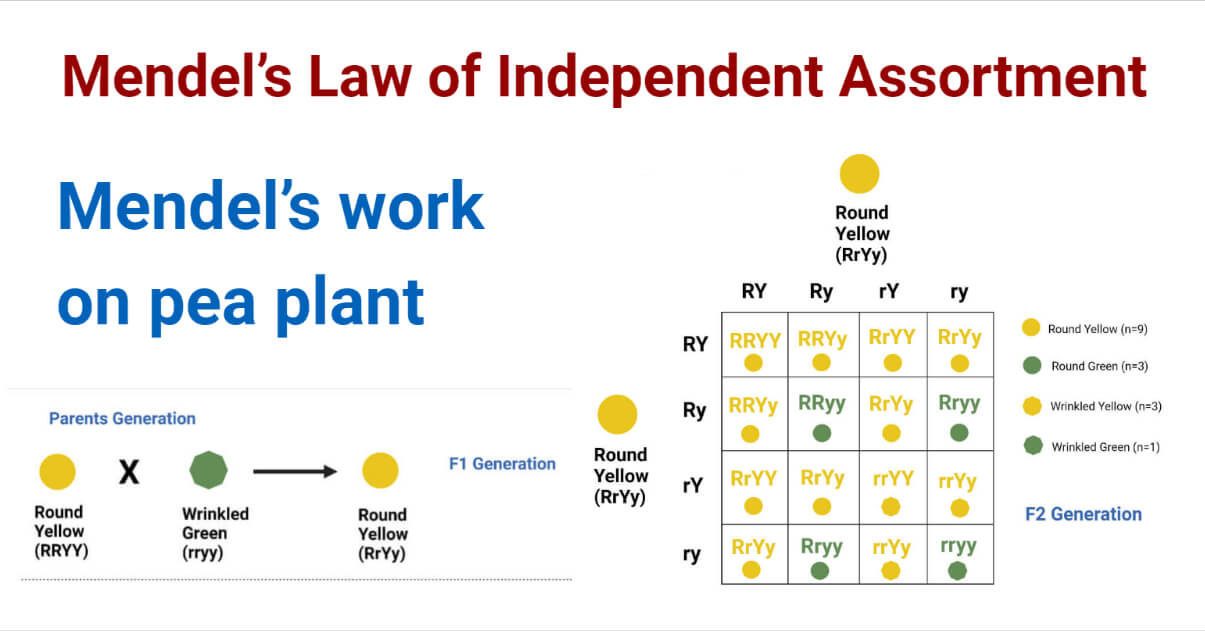Mendel’s Law of Independent Assortment states that ‘when the parents differ from each other in two or more pairs of contrasting characters, the inheritance of one pair of characters is independent of the other.’
- In simple words, the law states that all transfer of a particular character from parents to the offsprings remains unaffected by other characters.
- The law indicates that the alleles of different genes are assorted into the gametes independently of one another.
- Mendel’s work on dihybrid cross between different pea plants led to the discovery of this law as he observed that the combination of characters in the offspring did not always match that formed by the combination of the parental traits.
- The law explains the occurrence of a large number of combinations of genes from the same set of genes which couldn’t be explained previously.
Interesting Science Videos
Characteristics and Principle of Mendel’s Law of Independent Assortment
- The law of independent assortment, like the law of segregation, is based on meiosis cell division that occurs during sexual reproduction.
- During meiosis, the diploid chromosomes in the parents are separated to form the haploid gametes.
- The assortment of the chromosomes to the haploid gametes occurs independently of each other in a random manner.
- Thus, it is possible that the chromosomes from the same source can end up in different gametes, resulting in different characteristics.
- Independent assortment of genes is also based on recombination of chromosomes during meiosis which results in a further assortment of genes or characters.
- The pieces of chromosomes from the parents are assorted randomly during recombination resulting in the independent rearrangement.
- The mechanism of independent assortment can be studied by the example of a cross between a homozygous pea plant with yellow round seeds and a homozygous pea plant with green wrinkled seeds.
- The cross between these individuals produces distinct offspring where each pair of contrasting characters is expressed independently of the other characters.
- If the allele for the pea plant with yellow round seeds is YYRR and that with green wrinkled seeds is yyrr, the resulting offspring can have genotypes that include YyRR, YyRr, YYRr, YYrr, Yyrr, yyRR, and yyRr.
- This proves that even though the allele R is associated with the allele Y in the parent, it can express itself in other combinations.
Examples of Mendel’s Law of Independent Assortment
1. Mendel’s work on pea plant
- Mendel used the dihybrid cross between a homozygous pea plant with yellow round seeds and a homozygous pea plant with green wrinkled seeds. The parents have the alleles YYRR and yyrr, respectively.
- During meiosis, the chromosomes are separated so that only half the genes are transported to the gametes. The possible genotypes of the gametes then become YR and yr.
- As the parents are crossed, the fusion of the gametes results in the F1 hybrid with the YyRr genotype.
- The F1 hybrids have the phenotype of yellow round seeds as the dominant allele Y for yellow color, and the dominant allele R for the roundness is expressed.
- The alleles in F1 hybrids can now be segregated into four parts; Y for yellow color, y for green color, R for roundness, and r for wrinkledness.
- The four alleles can combine in a number of combinations to produce different genotypes and phenotypes.
- On further crossing, four types of gametes can be formed; YR, Yr. yR, and yr. These gametes fuse to form sixteen individuals in the F2 generation.
- The ratio of the F2 hybrids is 9 yellow round: 3 yellow wrinkled: 3 green round: 1 green wrinkled.
- This proves that both the characters are inherited independently of one another and are expressed according to their dominance.

2. Dihybrid Cross in Drosophila
- Another example of independent assortment can be observed in the dihybrid cross between homozygous long-winged and black-bodied Drosophila and a vestigial-winged, grey-bodied Drosophila.
- In this case, the long wing and grey body are the dominant characters. These characters are segregated and recombined during meiosis cell division which results in the random independent assortment of characters in the offspring.
- Even though the two characters occur together in the parents, these are inherited independently in the offsprings.
- The F2 generation of offsprings exists in four different phenotypes; long-winged grey-bodies, long-winged black-bodied, vestigial-winged grey-bodied, and vestigial-winged black-bodied.
Limitations of Mendel’s Law of Independent Assortment
Even though the law of independent assortment has been used as a mechanism to explain various genetic processes, there are some limitations associated with the law. Some of those limitations are listed below;
- The law of independent assortment doesn’t hold true for linked genes present on the same loci that are usually inherited together.
- The law is also not applicable for genetic traits where they exhibit incomplete dominance or codominance.
- In the case of characters that are inherited by multiple factors or genes, the law is also not applicable.
References and Sources
- Singh RS. Limits of imagination: the 150th Anniversary of Mendel’s Laws, and why Mendel failed to see the importance of his discovery for Darwin’s theory of evolution. Genome. 2015 Sep;58(9):415-21. doi: 10.1139/gen-2015-0107. Epub 2015 Aug 15. PMID: 26372894.
- Verma PS and Agarwal VK (3005). Cell Biology, Genetics, Molecular Biology, Evolution, and Ecology. Multicolored Edition.
- https://www.learninsta.com/class-12-biology-important-questions-chapter-5/ – 15%
- https://www.scienceabc.com/pure-sciences/mendels-laws-of-inheritance-what-is-the-law-of-independent-assortment.html – 6%
- https://quizlet.com/212216286/biology-study-guide-laws-of-segregation-independent-assortment-and-dominance-flash-cards/ – 3%
- http://www.pinkmonkey.com/studyguides/subjects/biology-edited/chap7/b0707501.asp – 2%
